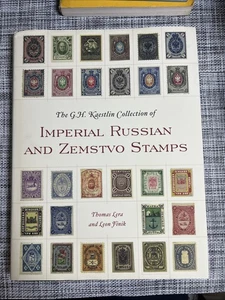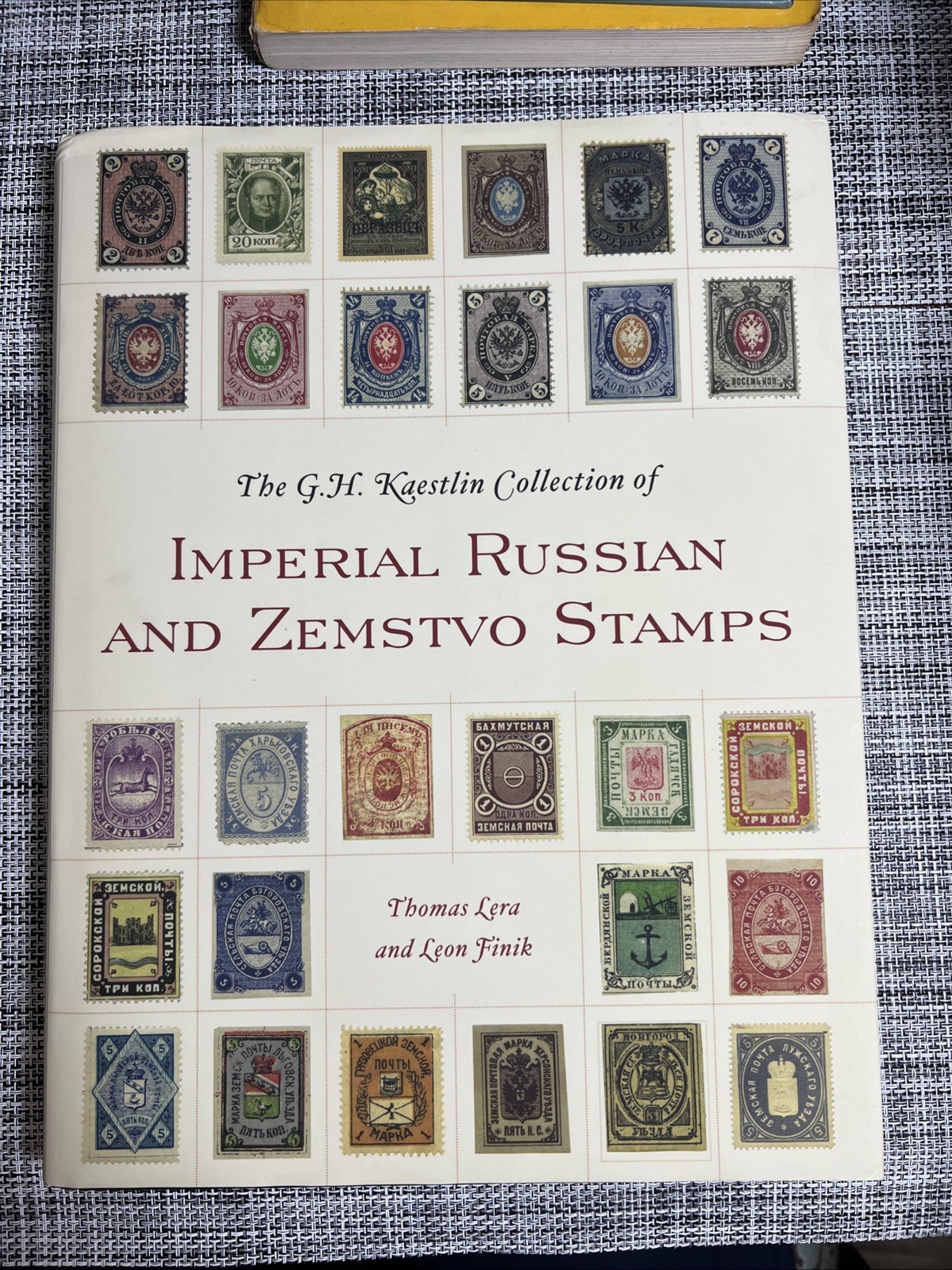Picture 1 of 4




Gallery
Picture 1 of 4




Have one to sell?
GH Kaestlin Collection of Imperial Russian and Zemstvo Stamps by Leon Finik and
US $124.95
ApproximatelyS$ 162.56
or Best Offer
Condition:
Oops! Looks like we're having trouble connecting to our server.
Refresh your browser window to try again.
Shipping:
US $7.47 (approx S$ 9.72) USPS Media MailTM.
Located in: Oxford, Florida, United States
Delivery:
Estimated between Wed, 5 Nov and Wed, 12 Nov to 94104
Returns:
No returns accepted.
Coverage:
Read item description or contact seller for details. See all detailsSee all details on coverage
(Not eligible for eBay purchase protection programmes)
Seller assumes all responsibility for this listing.
eBay item number:357699686100
Item specifics
- ISBN
- 9781935623113
About this product
Product Identifiers
Publisher
Smithsonian Institution Scholarly Press
ISBN-10
1935623117
ISBN-13
9781935623113
eBay Product ID (ePID)
159901632
Product Key Features
Language
English
Topic
Stamps, Russia & the Former Soviet Union, Collections, Catalogs, Exhibitions / General, European, Art, Antiques & Collectibles, History
Dimensions
Item Height
0.9 In.
Item Length
12.1 In.
Item Width
9.4 In.
Item Weight
59.1 Oz
Additional Product Features
Publication Year
2012
TitleLeading
The
Format
Hardcover
Book Title
GH Kaestlin Collection of Imperial Russian and Zemstvo Stamps
Intended Audience
Trade
Synopsis
A quiet philatelist, George H. Kaestlin joined the original Rossika Society in 1935 along with the better known Theo B. Lavroff and K. Szymanowski. Whereas Lavroff contributed significantly to Russian philately as an author and researcher and Szymanowski was an avid collector, Kaestlin collected privately. Born in Moscow, circa 1893, Kaestlin arrived in England in 1939. After World War II, When the original Rossika dissolved, he did not join the newly reconstituted Rossica Society of the United States. He never wrote for any philatelic magazine, never joined the London-based British Society of Russian Philately, and never showed his material at any exhibition. Thus he managed to elude notice in the literature of the times and receded into obscurity. Kaestlin's exceedingly remarkable contribution, however, is found in the quality and scope of his collection and in the preservation of the treasures he acquired (many from the legendary Fabergé collection).Kaestlin's attention to detail and fastidious collecting habits are evident in the layout and handwriting in his albums. His collection, donated to the Smithsonian Institution in 1984 by his niece Vera Madeleine Kaestlin-Bock, includes more than 1,250 album pages on which he organized more than 14,000 Imperial Russian and zemstvo stamps. The quality of the stamps is outstanding. With the publication of this book, Kaestlin can finally take his place among the greats of Russian philately. The G.H. Kaestlin Collection of Imperial Russian and Zemstvo Stamps is one of the greatest museum collections outside of Russia., Philatelist George H. Kaestlin's attention to detail and fastidious collecting habits are evident in the layout and handwriting in his albums. His collection, donated to the Smithsonian Institution in 1984 by his niece Vera Madeleine Kaestlin-Bock, includes more than 1,250 album pages on which he organized more than 14,000 Imperial Russian and zemstvo stamps. The quality of the stamps is outstanding. With the publication of this book, Kaestlin can finally take his place among the greats of Russian philately. The G.H. Kaestlin Collection of Imperial Russian and Zemstvo Stamps is one of the greatest museum collections outside of Russia., A quiet philatelist, George H. Kaestlin joined the original Rossika Society in 1935 along with the better known Theo B. Lavroff and K. Szymanowski. Whereas Lavroff contributed significantly to Russian philately as an author and researcher and Szymanowski was an avid collector, Kaestlin collected privately. Born in Moscow, circa 1893, Kaestlin arrived in England in 1939. After World War II, When the original Rossika dissolved, he did not join the newly reconstituted Rossica Society of the United States. He never wrote for any philatelic magazine, never joined the London-based British Society of Russian Philately, and never showed his material at any exhibition. Thus he managed to elude notice in the literature of the times and receded into obscurity. Kaestlin's exceedingly remarkable contribution, however, is found in the quality and scope of his collection and in the preservation of the treasures he acquired (many from the legendary Faberg collection). Kaestlin's attention to detail and fastidious collecting habits are evident in the layout and handwriting in his albums. His collection, donated to the Smithsonian Institution in 1984 by his niece Vera Madeleine Kaestlin-Bock, includes more than 1,250 album pages on which he organized more than 14,000 Imperial Russian and zemstvo stamps. The quality of the stamps is outstanding. With the publication of this book, Kaestlin can finally take his place among the greats of Russian philately. The G.H. Kaestlin Collection of Imperial Russian and Zemstvo Stamps is one of the greatest museum collections outside of Russia., A quiet philatelist, George H. Kaestlin joined the original Rossika Society in 1935 along with the better known Theo B. Lavroff and K. Szymanowski. Whereas Lavroff contributed significantly to Russian philately as an author and researcher and Szymanowski was an avid collector, Kaestlin collected privately. Born in Moscow, circa 1893, Kaestlin arrived in England in 1939. After World War II, When the original Rossika dissolved, he did not join the newly reconstituted Rossica Society of the United States. He never wrote for any philatelic magazine, never joined the London-based British Society of Russian Philately, and never showed his material at any exhibition. Thus he managed to elude notice in the literature of the times and receded into obscurity. Kaestlin's exceedingly remarkable contribution, however, is found in the quality and scope of his collection and in the preservation of the treasures he acquired (many from the legendary Fabergé collection). Kaestlin's attention to detail and fastidious collecting habits are evident in the layout and handwriting in his albums. His collection, donated to the Smithsonian Institution in 1984 by his niece Vera Madeleine Kaestlin-Bock, includes more than 1,250 album pages on which he organized more than 14,000 Imperial Russian and zemstvo stamps. The quality of the stamps is outstanding. With the publication of this book, Kaestlin can finally take his place among the greats of Russian philately. The G.H. Kaestlin Collection of Imperial Russian and Zemstvo Stamps is one of the greatest museum collections outside of Russia.
Number of Pages
314 pages
Item description from the seller
Seller feedback (813)
- 0***0 (94)- Feedback left by buyer.Past 6 monthsVerified purchaseI’m so happy! As described. Good packaging and fast shipping. Good value. Good seller!Retro Vintage Versace Woman Sunglasses (#356916270672)
- 8***1 (336)- Feedback left by buyer.Past 6 monthsVerified purchaseGreat price! Fast shipping! Packaged well! Items as described! Can't ask for more!! Great seller!! A+++++Top Gear: the Complete Second Season (USA) (DVD) (#357078881685)
- 3***2- Feedback left by buyer.Past 6 monthsVerified purchaseI am happy with my purchase. My item was packaged well and shipped fast. The item was as described and I think the price was great. Thank you seller! A++++

